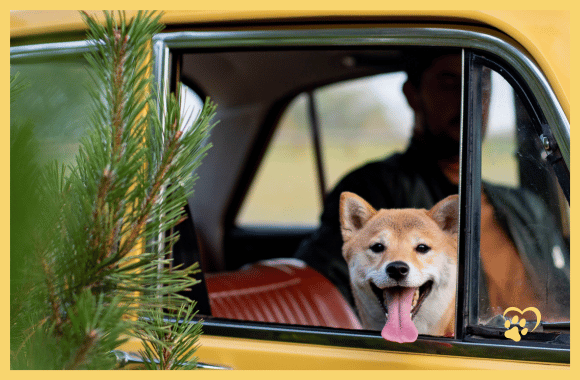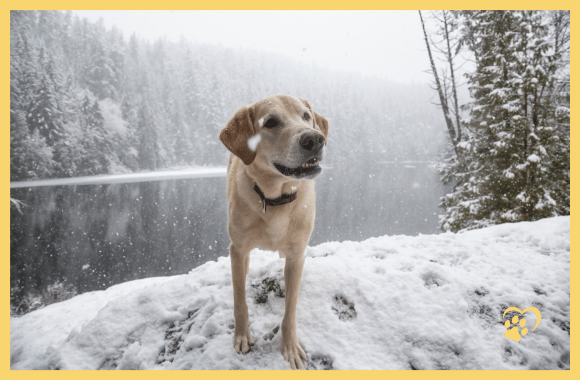A road trip with a dog can be unforgettable. Careful planning is essential so that you can enjoy this time to the full. We give you practical tips on route planning, packing lists and safety on board.
Plan your road trip
The better you plan, the more time you have to enjoy your trip, simply because your mind is not occupied with organizational matters.
Choosing the right route
- Take your dog's needs into account
Think about how long your dog can sit in the car, whether he likes driving and whether there are certain places he likes to visit. Choose routes that offer enough opportunities for breaks and exercise. - Search for dog-friendly attractions and accommodation
Find places along the route that your dog might enjoy. These can be parks, hiking trails, restaurants or accommodation where dogs are welcome. This way you can be sure that your dog will enjoy the trip as much as you do.
Scheduling and breaks
- Important aspects of time planning
When planning your time, take into account how long your dog can travel comfortably in the car. Plan regular breaks so that your dog can relieve itself, stretch and drink. Also plan enough time for the journey so that you don't have to rush. - Frequency and duration of breaks for the dog
How often and how long you should give your dog a break depends on various factors, including your dog's physical condition, the weather and the length of the trip. As a rule of thumb, you should take a break every two to three hoursso that your dog can relax and move around. Let him stretch, have a drink and perhaps play with a small toy to make the ride more enjoyable.
Packing list for traveling with your dog
If you are preparing for a road trip with your dog, you should have everything you need with you. Here you will find a practical packing list so that you are well equipped:
Food and drink
- Sufficient food for the entire travel time, plus a reserve for unexpected delays
- Portable bowls or bowls for food and water
- Sufficient water for the dog, especially in warm weather or on longer journeys
- Treats or snacks to reward or cheer up your dog on the go
- Feed bag or can to keep the food fresh and dry
- Disposable bags or biodegradable poop bags for disposing of dog waste on the go
- Drinking bottle with integrated water dispenser for on the go, so that your dog always has fresh water available
- Waterproof containers to protect food and treats from moisture
- Thermos flask or insulated container to keep the food warm or cool as required
Sleeping area and rest area
- Blanket or pillow so that your dog can sleep comfortably in the car or accommodation
- Transport box or net, if your dog sleeps better in it and feels safer
- Familiar toys or items of clothing that smell like you, so that your dog feels safe in the back seat and later in unfamiliar accommodation
- Umbrella or sunshade for the rest area to protect your dog from the elements
- Foldable or inflatable dog bed for on the go, so your dog can sleep comfortably anywhere
- A sleeping mat or additional blankets for your dog to protect him from cold or hard surfaces
- Soft toy or cuddly blanket to give your dog a feeling of safety and security
First-aid kit and first-aid kit for dogs
- Medication, if your dog needs it
- Plasters and disinfectant for minor injuries
- Tick tweezers and tick and flea repellent
- Telephone number of the nearest vet along the route
- Cooling pack or cooling blanket in case your dog overheats during the journey
- Antibacterial wipes or cleaning products for your dog's hygiene on the go
- Collar or protective collar to prevent your dog from licking or scratching injuries or wounds
- Eye wash or eye drops to remove foreign bodies or irritation from your dog's eyes
- Sedatives or natural relaxation methods if your dog suffers from travel anxiety
Toys and activities
- Your dog's favorite toy to keep him busy during the trip or at the accommodation
- Chew toys or snacks to prevent boredom and keep your dog occupied
- Ball or frisbee for spontaneous games at rest areas or in parks along the route
- Interactive toys or brain games for your dog's mental challenge
- New toys or treats to make the journey interesting and exciting
- Water toys for dog baths in lakes or rivers along the route
- Tug toys or ropes to interact with your dog and release his energy

Safety and comfort for your dog
When you are out and about with your dog, safety and well-being are paramount.
Means of transportation and safety precautions
- Choose the right means of transportation
Which means of transportation is best for your dog depends on various factors such as size, breed and personal preferences. Some dogs feel safer in a transport box, while others prefer to travel on a car seat or a blanket in the trunk. Choose the mode of transport that is best suited to your dog and offers it sufficient space and safety. - Safety harnesses, transport boxes or nets for the dog
Regardless of which means of transport you choose, it is important that your dog is secured during the journey to avoid injury. Seat belts, transport boxes or nets can help to secure your dog and protect it from sudden braking maneuvers or accidents. Make sure that the safety system complies with the applicable safety standards and allows your dog sufficient freedom of movement.
Comfort equipment for the dog
- Tips for designing the dog area in the vehicle
Make the dog area in the vehicle as comfortable as possible for your four-legged friend. Place a soft blanket or cushion in the trunk or on the back seat so that your dog can lie down comfortably. Make sure that the area is well ventilated and that your dog has access to fresh air. Place his favorite toy or a chew to keep him occupied and distracted during the journey. - Take water, food and his favorite toy with you
Don't forget to carry water and food for your dog during the trip to keep him hydrated and energized. Use portable food bowls or dishes to give your dog water and food. Also take his favorite toy with you to give him something familiar and soothing during the ride.
By taking these measures, you can ensure that your dog is protected and comfortable during the trip.
Tips for on the go
Anything can happen on a trip with your dog - both positive and negative. After all, that's the attraction of such a trip.
Dog care and hygiene when traveling
- Brush your dog's coat regularly to remove dirt and loose hair and keep the coat healthy.
- Clean your dog's paws after outdoor walks to remove dirt, mud or road salt and prevent infections.
- Keep your dog's ears and eyes clean and dry to prevent infections.
- If necessary, apply a repellent against fleas, ticks and other parasites to protect your dog from annoying bites and diseases.
- Check your dog's claws regularly and trim them if necessary to avoid injury and pain.
- Watch out for signs of skin irritation or allergic reactions and treat them immediately to ensure your dog's well-being.
Strategies for avoiding travel sickness
- Do not allow your dog to eat too much before traveling to avoid nausea.
- Avoid abrupt movements and braking maneuvers to reduce the risk of motion sickness.
- Ventilate the vehicle regularly and ensure sufficient ventilation to improve the air quality in the vehicle.
- Give your dog access to fresh air during the journey by opening a window slightly or using a ventilation flap.
- Reduce the speed at which you travel and plan regular breaks so that your dog can relax and get used to the exercise.
- Avoid feeding your dog during the journey as this can lead to nausea. Instead, give him a small meal before the journey and offer him something to drink during the breaks.
Mastering unexpected situations on the road
- Stay calm and composed in unexpected situations so as not to unsettle your dog.
- Always carry an emergency kit and important contact numbers with you, including the vet and emergency services.
- Stop regularly to give your dog the opportunity to relieve itself, drink and stretch.
- Be flexible and adapt your travel plans to unexpected events if necessary to ensure the safety and well-being of your dog.
- Take enough water and food for your dog with you if you are traveling longer than planned. It is important that your dog is sufficiently hydrated and well nourished to avoid exhaustion and dehydration.
- Keep important documents such as your dog's vaccination certificate, contact details and emergency information to hand in case you need them during your trip.
You can find even more information about dogs and cars in the following articles:
- From clothes to car: the ultimate guide to removing dog hair

- Driving with a dog: the best strategies for a safe journey
- 10 dog breeds that love every car journey: The ultimate guide for travel-loving dog owners | with pictures


Health and emergency preparedness
To ensure that your trip with your dog runs smoothly, take care of a few details in advance.
Current health checks and vaccinations
- Make sure that your dog has had an up-to-date health check at the vet before traveling. This will check the vaccination status and ensure that your dog is healthy enough for the trip.
- Make sure all your dog's vaccinations are up to date, including rabies and other diseases relevant to the region. This is especially important if you are traveling to areas where certain diseases are common.
Emergency first aid kit for dogs
- Put together an emergency first-aid kit for your dog containing important medication and bandages. This includes bandages for minor injuries, disinfectant, tick tweezers, eyewash, charcoal tablets for poisoning and other important items.
- Don't forget to take along the medication your dog needs to take regularly and a sufficient amount of prescribed medication for the duration of the trip.
Contact details of vets along the route
- Research vets along your planned route in advance and make a note of their contact details and opening hours. This will give you quick access to veterinary help in an emergency. This tip may seem old-fashioned, and if you can rely on your internet connection and aren't moving into the wilderness, it's probably superfluous. But if you have an emergency somewhere in the middle of nowhere with a weak internet connection, you'll be glad of your printed list.
- Save the telephone numbers of veterinary clinics and emergency services in your cell phone and carry a printed list of emergency contacts in your vehicle.
If you follow these measures, you can be sure that your dog will be well looked after during the trip and will receive the help it needs quickly in an emergency.
Enjoy your road trip with your dog to the fullest
Have you noted down all the tips for your road trip with your dog? Then you're ready to go! With these practical tips and a well-organized packing list, you'll both be well equipped for an adventure on four wheels. Enjoy the ride, admire the scenery and cherish the time with your faithful companion. A road trip with a dog is not just a journey, but a shared memory for life. Have fun!
